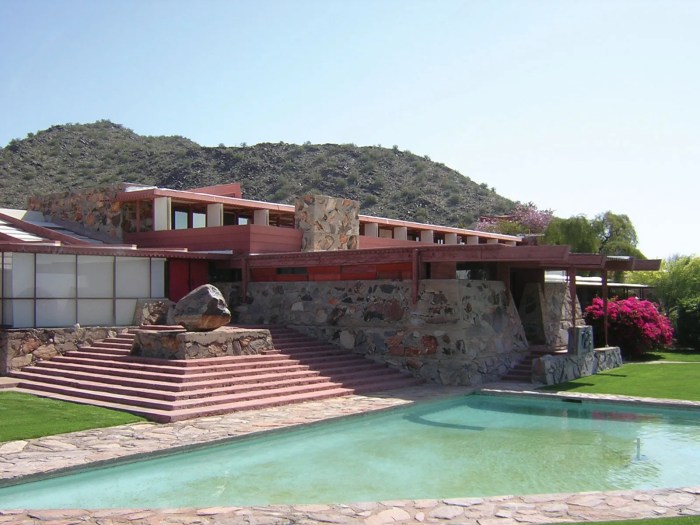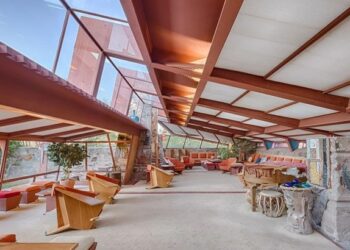Embark on a journey through the captivating world of Frank Lloyd Wright's Taliesin West, where history, architecture, and nature converge to create a truly unique experience. As we delve into the rich tapestry of Taliesin West, we uncover the profound impact it has had on modern architecture and design.
Delve deeper into the architectural marvel that is Taliesin West, and discover the intricate details that make it a true masterpiece of its time.
Introduction to Frank Lloyd Wright Taliesin West
Frank Lloyd Wright Taliesin West holds a significant place in the life of the renowned architect, Frank Lloyd Wright. Built as his winter home, studio, and architectural campus, Taliesin West served as a creative sanctuary and experimental ground for Wright's innovative ideas.The architectural style and design principles employed at Taliesin West reflect Wright's philosophy of organic architecture, seamlessly blending with the natural desert landscape of Arizona.
The use of local materials, earth-toned colors, and low, horizontal lines characterize the design, creating a harmonious relationship between the built environment and the surrounding nature.Situated in the Sonoran Desert near Scottsdale, Arizona, Taliesin West boasts breathtaking views of the desert landscape, with rugged mountains as a backdrop.
The location of Taliesin West not only inspired Wright's design but also provided a tranquil setting for artistic exploration and architectural innovation.
Architecture at Taliesin West

At Taliesin West, the architecture is a true reflection of Frank Lloyd Wright's vision, blending seamlessly with the surrounding desert landscape.
Unique Features of the Buildings
The buildings at Taliesin West showcase Wright's innovative use of natural materials like local stone and wood, along with his signature design elements such as low horizontal lines, flat roofs, and open floor plans. The structures are built into the desert terrain, incorporating elements like cantilevered roofs and terraces that provide stunning views of the landscape.
Materials Used in Construction
Wright utilized materials that harmonized with the desert environment, including desert masonry, redwood, and canvas. These materials not only blend aesthetically with the surroundings but also help regulate temperature and create a sense of unity between the buildings and the natural landscape.
Integration with the Natural Landscape
The architecture at Taliesin West seamlessly integrates with the natural landscape through the use of earth-toned materials, low-profile structures, and large windows that frame views of the surrounding desert. Wright's design philosophy was to create buildings that appear as extensions of the land itself, rather than imposing structures that disrupt the environment.
Life at Taliesin West
Living and working at Taliesin West was a unique experience for Frank Lloyd Wright and his apprentices. The desert environment influenced their daily routines and activities in various ways.
Living Quarters
At Taliesin West, Frank Lloyd Wright and his apprentices lived in communal spaces, including sleeping quarters, dining areas, and studios. The living quarters were designed to blend with the natural surroundings, incorporating elements of the desert landscape into the architecture.
Daily Routine
The daily routine at Taliesin West was structured around work, study, and communal activities. Mornings often began with breakfast followed by design workshops, lectures, and construction projects. Afternoons were dedicated to individual work or exploring the desert landscape for inspiration.
Influence of the Desert Environment
The desert environment had a profound impact on life at Taliesin West. The architecture of the buildings was designed to harmonize with the natural surroundings, using materials like sandstone and redwood to blend in with the desert landscape. The extreme temperatures and arid climate also influenced the design of the buildings, with features like shading devices and natural ventilation to ensure comfort and sustainability.
Legacy of Taliesin West

Taliesin West, the desert masterpiece designed by Frank Lloyd Wright, has left a lasting impact on modern architecture. Its innovative use of local materials, integration with the natural landscape, and organic design principles have inspired countless architects and designers around the world.
Impact on Modern Architecture
Taliesin West's unique architecture challenged traditional conventions, emphasizing the importance of harmony between built environments and nature. Its low-slung buildings, earth-toned colors, and incorporation of natural light have influenced the design of sustainable and environmentally-conscious structures today.
Inspiration for Architects and Designers
The legacy of Taliesin West lives on through its continuing influence on contemporary design. Architects and designers are drawn to its principles of unity, simplicity, and connection to the surroundings, inspiring them to create spaces that are not only visually striking but also in harmony with the environment.
Preservation and Educational Institution
Efforts to preserve Taliesin West ensure that future generations can experience and learn from its architectural significance. Today, Taliesin West serves as a living laboratory for aspiring architects and designers, offering educational programs that promote Wright's principles of organic architecture and innovation.
Final Conclusion

In conclusion, the legacy of Taliesin West stands as a testament to Frank Lloyd Wright's innovative spirit and visionary approach to design. As we reflect on its influence on the architectural world, we are reminded of the enduring legacy that continues to inspire and captivate generations to come.
FAQ Resource
What is the significance of Taliesin West in Frank Lloyd Wright's life?
Taliesin West served as Frank Lloyd Wright's winter home and architectural school, reflecting his love for the desert landscape and innovative design principles.
How does the architecture at Taliesin West integrate with the natural landscape?
The architecture at Taliesin West seamlessly blends with the surrounding desert environment, utilizing natural materials and organic design elements.
What impact has Taliesin West had on modern architecture?
Taliesin West has significantly influenced modern architecture by showcasing a harmonious relationship between man-made structures and nature.











